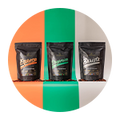Unless you’ve been living under a rock for the past five years, chances are you’ve come across the term ‘Keto Diet’. This low carbohydrate, high fat diet has fast become one of the most popular ways to lose weight. So why are people so obsessed? If you’re considering trying it or simply wanting to find out what all the hype is about, keep reading for everything you need to know.
What is the Keto Diet?
The Keto Diet has been used for hundreds of years to treat various medical conditions, however its popularity has come about in previous years thanks to its effect on weight loss. It’s a low carbohydrate diet, but what makes it different to other low carb diets is that it’s paired with a high fat content and moderate protein.
It’s often described as a ‘way of eating’ and not just a diet. Keto sites explain that the reason being is that you can’t just stop and start like other diets and that to really gain results and benefits, it requires daily consistency and might even mean a whole lifestyle change.
Generally, a ‘Keto Diet’ consists of 70-80% fats, 10-20% protein and 5-10% carbohydrates. In a 2000 calorie diet, this would equal 165g of fat, 40g of carbs and 75g of protein.
How does it work?
The theory behind the keto diet is that if you take away most of the body’s natural energy source, glucose, which is produced from eating carbohydrates, then the body starts to make a new energy source called ‘ketones’ which are converted out of fats (hence where the name Keto Diet comes from). It’s said that after 3-4 days of depriving your body from carbs, your body will ‘switch’ to using ketones for energy. This is called ‘Ketosis’. However, the lack of carbs/glucose in your body needs to be kept low to maintain Ketosis.

What foods does the Keto Diet consist of?
Before you get too excited, let’s start with the foods you can’t have while living the keto life. Even though you can allow for a little bit of carbs each day, all ‘versions’ of the diet ban foods that are high-carb. These include bread, cereal, pasta, rice, pizza, biscuits, potatoes, as well as foods and drinks high in sugar (glucose).
However, you can go for your life (within your daily calorie requirements) on the following: water, black coffee, tea, processed meats, butter, avocado, peanut butter, nuts, fish and oils such as avocado, coconut and MCT.
What are the benefits of the Keto Diet?
When your body starts using fats/ketones for energy, it allows your body to be able to burn body fat easier, too. Over 30 different studies have shown the Keto Diet to be more effective than other traditional ‘low carb’ diets. The Keto Diet can also help to suppress appetite, so you’re less likely to overeat.
In addition to becoming a fat-burning machine, the Keto Diet can help you boost your brain power, so you can thrive in all aspects of your life. Keto sites explain that the brain doesn’t need carbs to function and that ketones are a great brain fuel. So when your body is in Ketosis, you have a constant flow of energy which can allow for greater concentration and mental focus.

What is the ‘Keto Flu’?
Some people who start the Keto Diet describe feeling slightly nauseous, a bit flat or headachy. Keto sites say this is completely normal and can be caused by your body adjusting to its new energy source of fats. So while your body is still running on carbs, having them dropped low can cause you to feel a bit in the slumps before you tap into your new fat-burning lifestyle.
Should I try the Keto Diet?
As we’ve said earlier, the Keto Diet is considered a way of life and may even require a complete lifestyle overhaul. So if you’re addicted to pasta, live off doughnuts or can’t go a week without pizza - then maybe the Keto way isn’t for you. But life is all about balance, right?









